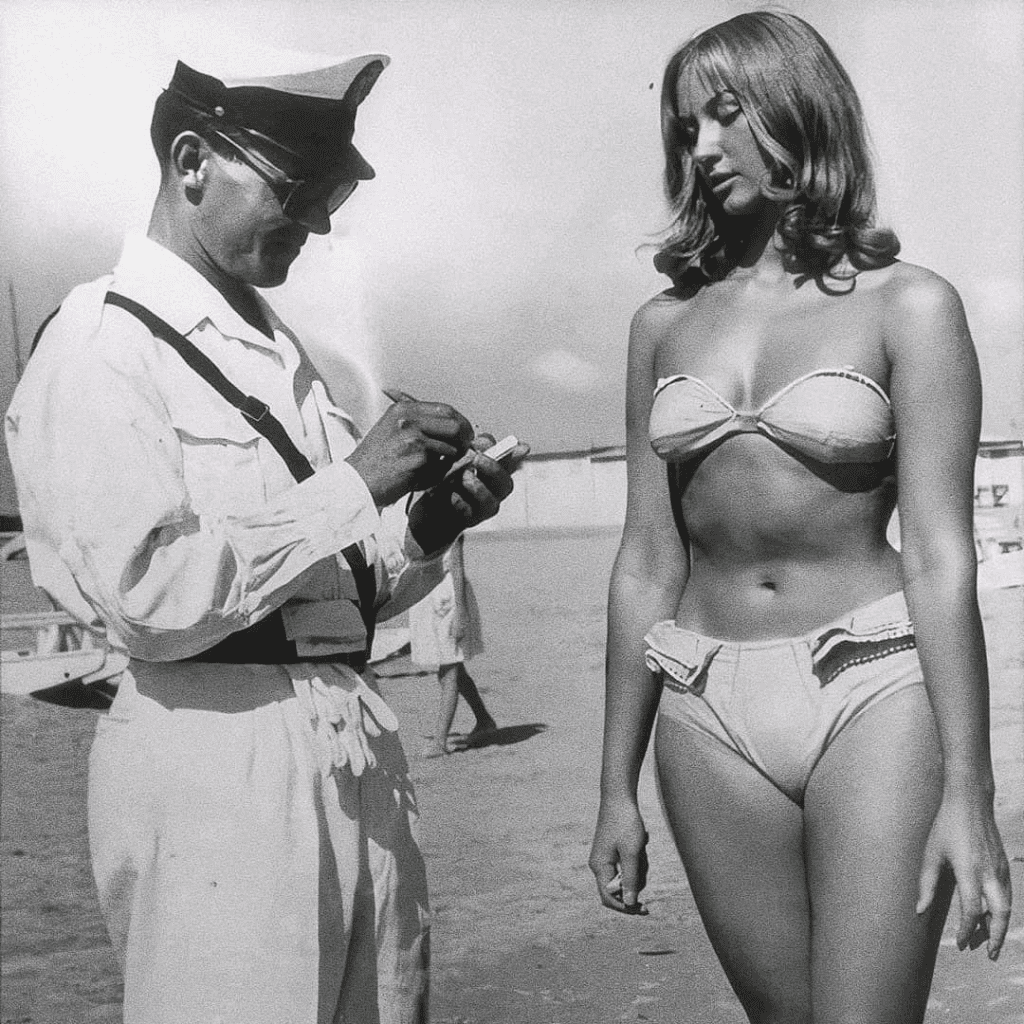The Hidden Story Behind a Beach Photo That Sparked a Global Uproar

At first glance, it’s just a vintage beach photo—a woman in a bikini and a stern man in uniform scribbling something. But look again. That innocent image captures a pivotal moment in cultural history: the battle between modesty and liberation, waged over a tiny piece of fabric—the bikini.
How Bathing Suits Went from Wool to Wow
It’s wild to think, but a little over a century ago, women at the beach wore full-length, woolen garments that covered them from neck to knee. The goal wasn’t comfort or style—it was all about modesty. Public beaches even had “modesty patrols.” In Washington, D.C., officers measured skirt lengths with rulers. In Chicago, tailors waited at Clarendon Beach to sew up any swimsuit deemed “too daring.” Forget fun in the sun; just showing a bare shoulder could get you fined.
Annette Kellerman: The Mermaid Who Made Waves
But then came 1907 and a daring Australian swimmer named Annette Kellerman. Fed up with being weighed down by soggy layers, she wore a one-piece suit that exposed her arms and legs—practically scandalous for the time. She was reportedly arrested for indecency. While records are hazy, the moment made headlines and turned Kellerman into a symbol of modern swimwear. Her self-named swimwear line, “Annette Kellermans,” signaled the start of a slow, determined shift toward practicality and freedom.
Video: History Brief: 1920s Flappers
The Roaring ’20s and the Rise of Rebellion
As flapper culture shook up fashion in the 1920s, beachwear began loosening up too. A group of women in California—boldly named the “skirts be hanged girls”—ditched long skirts and promoted form-fitting suits that let them actually swim. Still, society wasn’t ready for bare midriffs or high-cut thighs. Every new inch of exposed skin sparked fresh debates over decency.
1946: The Bikini Detonates Like a Bomb
And then, boom—the bikini. French engineer Louis Réard introduced the two-piece suit just days after nuclear tests at Bikini Atoll, and the name wasn’t a coincidence. Réard claimed his design was as “explosive” as an atomic bomb—and he wasn’t wrong.
The bikini showed the navel, a shocking move in an era of conservative fashion. It was so controversial that Réard couldn’t find a model willing to wear it—so he hired a nude dancer. The stunt worked. The bikini grabbed headlines, but it also triggered outrage across the globe.

Global Bans, Religious Backlash, and Public Shaming
Governments acted fast. France banned bikinis from public beaches in 1949. Spain, Belgium, Italy, and Portugal followed. Germany’s public pools didn’t allow them until the 1970s. Even the Vatican stepped in. Pope Pius XII called the bikini sinful. In Australia, Ann Ferguson was asked to leave Surfers Paradise beach in 1952 for showing too much skin.
That now-famous black-and-white photo? A female beachgoer in a bikini standing next to a uniformed officer, who appears to be writing her a ticket. It was taken in Italy, where modesty laws were in full effect. Whether she was actually fined remains uncertain, but the image symbolized a very real clash: between a woman’s right to wear what she wants and a society desperate to keep her covered.

Hollywood Hesitates, Then Surrenders
For a while, American cinema played it safe. The Hays Code banned navel exposure in films. Groups like the National Legion of Decency applied pressure to keep bikinis off screens. But even rules can’t stop a revolution.
Enter Brigitte Bardot. In The Girl in the Bikini, her carefree confidence redefined what femininity could look like. She wasn’t vulgar—she was radiant, relaxed, and unapologetically herself. Then came Ursula Andress in 1962’s Dr. No, rising from the surf in a white bikini with a knife strapped to her side. It wasn’t just sexy—it was powerful. A woman as strong and commanding as any man.
Video: Brigitte Bardot – Moi Je Joue
The 1970s and Beyond: Liberation Becomes the Norm
By the ’70s, the bikini wasn’t a scandal—it was a staple. Fashion evolved even further. String bikinis. Thongs. High-cut legs. Crop tops. And it wasn’t just women; men’s swimwear shrank too. The message was clear: swimwear wasn’t about shame anymore. It was about freedom, expression, and confidence.
The Bikini Today: More Than Skin Deep
Now, we live in an era where fashion is about choice, not rules. Want to wear a one-piece? Go for it. Prefer a cheeky thong bikini? You do you. The conversation has shifted from “how much skin is too much?” to “how do you feel in your skin?”
Swimwear now reflects diversity—different body types, genders, styles, and stories. It embraces body positivity. It’s not about turning heads. It’s about turning inward and asking: do I feel confident? Comfortable? Free?

From Scandal to Symbol: Why the Bikini Still Matters
That one tiny garment, once blamed for moral decay and social rebellion, is now celebrated for representing something much deeper—freedom. It tells the story of how far women have come in reclaiming public space, bodily autonomy, and the right to simply exist without shame.
So the next time you see an old beach photo or slip into your favorite swimsuit, remember: this isn’t just about fashion. It’s about defiance, resilience, and a journey from judgment to joy.